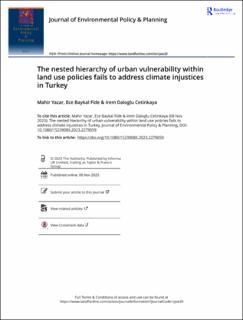| dc.contributor.author | Yazar, Mahir | |
| dc.contributor.author | Fide, Ece Baykal | |
| dc.contributor.author | Cetinkaya, Irem Daloglu | |
| dc.date.accessioned | 2024-02-13T11:42:53Z | |
| dc.date.available | 2024-02-13T11:42:53Z | |
| dc.date.created | 2023-11-09T13:13:02Z | |
| dc.date.issued | 2024 | |
| dc.identifier.issn | 1523-908X | |
| dc.identifier.uri | https://hdl.handle.net/11250/3117248 | |
| dc.description.abstract | Responsive land-use policy amid climate change in urban settings includes infrastructure transformation and necessitates recognizing community- and individual-level vulnerabilities as well as climate-driven injustices, which are isolated in the existing literature. This paper highlights how climate policies set in the nine cities of Turkey identify vulnerable groups and individuals, and develop land-use policy to address the identified vulnerabilities and climate justice concerns. Employing policy content analysis and expert interviews, we find critical relationships between the identified vulnerable groups, responsive land-use policy, and climate justice. While social-aid municipalism-related vulnerabilities dominate the districts’ climate policies, nature-based solutions (NBS), especially green infrastructure and urban agriculture, emerge as the dominant climate adaptation solutions. The way urban vulnerabilities are prioritized in the climate and sustainability plans put less emphasis on intersectionality and urban infrastructure-related vulnerabilities. With tokenism of justice taking place in policy documents, the plans do not incorporate vulnerable communities in land-use planning. Ultimately, the complexity of responsive land-use policies for cities must cultivate a greater awareness of how to support vulnerable communities practically. | en_US |
| dc.language.iso | eng | en_US |
| dc.publisher | Taylor & Francis | en_US |
| dc.rights | Navngivelse 4.0 Internasjonal | * |
| dc.rights.uri | http://creativecommons.org/licenses/by/4.0/deed.no | * |
| dc.title | The nested hierarchy of urban vulnerability within land use policiesfails to address climate injustices in Turkey | en_US |
| dc.type | Journal article | en_US |
| dc.type | Peer reviewed | en_US |
| dc.description.version | publishedVersion | en_US |
| dc.rights.holder | Copyright 2023 The Author(s) | en_US |
| cristin.ispublished | true | |
| cristin.fulltext | original | |
| cristin.qualitycode | 1 | |
| dc.identifier.doi | 10.1080/1523908X.2023.2279059 | |
| dc.identifier.cristin | 2194578 | |
| dc.source.journal | Journal of Environmental Policy and Planning | en_US |
| dc.source.pagenumber | 30-46 | en_US |
| dc.identifier.citation | Journal of Environmental Policy and Planning. 2024, 26 (1), 30-46. | en_US |
| dc.source.volume | 26 | en_US |
| dc.source.issue | 1 | en_US |

